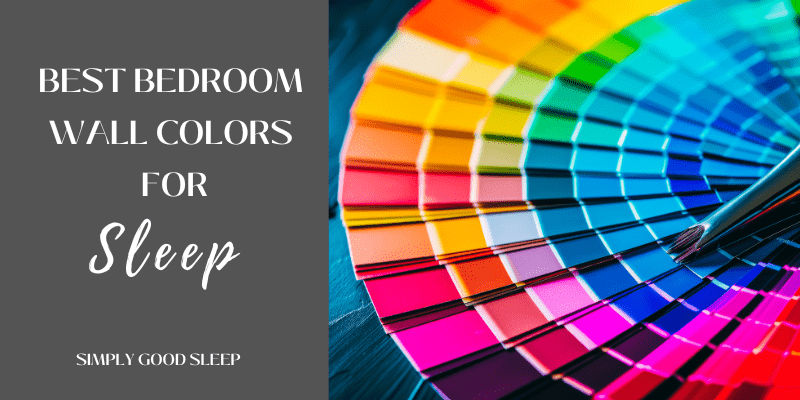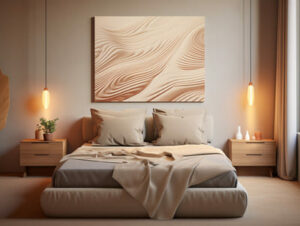
The colors surrounding us wield significant influence over our emotions, behaviors, and even our sleep patterns. Among the spaces we inhabit, our bedrooms hold a special place as sanctuaries of rest and rejuvenation. The choice of wall colors within these bedroom spaces is not merely an aesthetic decision. It is an important factor in fostering an environment conducive to quality sleep. This post will aim to unravel the mysteries behind the best bedroom wall colors for a good night’s sleep.
Join us on this journey to discover the palette that can transform your bedroom into an oasis of tranquility, where the walls not only speak beauty but also whisper peaceful dreams.
Understanding the Impact of Colors on Sleep
Colors do more than just please the eye—they quietly influence our moods, emotions, and even our sleep. Have you ever noticed how a bright red energizes you, while a soft blue calms your mind? This isn’t a coincidence; it’s color psychology at work. It studies how different hues affect our mental and emotional states.

When it comes to sleep, color psychology is crucial. Our bedrooms, where we seek comfort after a long day, need special attention. Research shows that certain colors can relax our minds and bodies, helping us transition from wakefulness to sleep. Soft shades of blue, like a clear sky, can lower blood pressure and heart rate, creating a sense of calm. Gentle greens – such as sage green and pistachio green – can evoke balance and harmony; these colors can also foster a peaceful atmosphere perfect for unwinding.
The science behind this lies in how colors interact with our brains. Specific light wavelengths linked to different colors stimulate various brain parts and trigger hormonal responses that influence our mood and behavior. Our bodies also follow a natural circadian rhythm, and exposure to certain colors at the right times can support or disrupt this cycle.
By understanding these mechanisms, we can use the best bedroom wall colors for sleep to our advantage. Choosing colors that promote relaxation and tranquility isn’t just about aesthetics. It’s about creating a calming atmosphere that helps the body and mind unwind, paving the way for a restful night’s sleep.
Best Bedroom Wall Colors That Promote Better Sleep
Choosing the best bedroom wall colors for sleep isn’t a one-size-fits-all decision. Different colors have unique psychological effects that influence our emotions and sleep patterns.
Soft shades of blue, like a clear sky, are known for their calming effects. They help lower stress levels and create a peaceful atmosphere perfect for sleep. Subtle greens, inspired by nature, bring a sense of balance and harmony, making your bedroom feel like a soothing retreat.
Lavender and lilac tones also have calming effects. They reduce heart rate and anxiety, setting the stage for peaceful slumber. While these colors are great for sleep, other hues can also create a restful environment.
Neutral colors like warm beige or light brown offer comfort and coziness. They provide a subtle backdrop that pairs well with various decor styles while maintaining a soothing vibe.
Best Bedroom Wall Colors: Factors Influencing Color Choice
Choosing the best bedroom wall colors for sleep involves more than just personal preference. Several factors, such as cultural influences, individual tastes, room size, natural lighting, and the desired ambiance, also can play a role in selecting the perfect hue.
Personal preferences are crucial. Some people find relaxation in cool tones like blues and greens, while others might prefer the warmth of neutral colors or even soft yellows and blush pinks. Understanding your emotional response to different colors is key to creating a welcoming and soothing sleep environment.
Cultural influences also shape how we perceive colors. For example, red might symbolize energy and passion in some cultures, making it less suitable for a relaxing bedroom. Considering cultural connotations helps ensure that your chosen color promotes relaxation rather than causing alertness.
Room size and natural lighting significantly affect how colors appear and feel. In smaller rooms, darker colors might feel confining; however, in larger spaces, they can create a cozy atmosphere. Similarly, rooms with plenty of natural light can handle deeper or brighter colors better than those with minimal light, changing the overall ambiance.
Harmonizing colors with a complementary palette and considering accents and decor elements are also important. The interplay between wall color and furnishings, bedding, or artwork can enhance the room’s overall mood and contribute to a more cohesive, relaxing atmosphere.
By understanding and navigating these influences, you can thoughtfully select the best bedroom wall colors for sleep. This tailored approach creates a restful and rejuvenating sleep environment that aligns with your preferences.
Practical Implementation and Design Tips
Choosing the best bedroom wall colors for sleep is just the beginning. Implementing these colors effectively involves using design strategies that enhance their calming effects.
Painting techniques can change how a color looks and feels. A matte finish absorbs more light, creating a soft, calming atmosphere. A glossy finish reflects light, brightening the room. Textured finishes like suede or stippling add depth and visual interest, affecting how the color interacts with lighting.

Thoughtfully combining colors can amplify their soothing effects. An accent wall in a bolder hue or using complementary tones in accessories can enhance the ambiance. Use a primary calming color on the walls and introduce softer tones through bedding, curtains, or rugs to create a cohesive and appealing space.
Consider the room layout and furniture placement. The wall color should complement focal points and create a harmonious flow. Strategic furniture placement can influence how the color is perceived and its overall impact on the room’s feel.
Accessorize with elements that match the color scheme, such as artwork, plants, or lighting fixtures, to create a calming atmosphere. Soft, warm, dimmable lights in the evening can complement the wall color, setting the stage for relaxation before bedtime.
By incorporating these practical implementation and design tips, you can transform your bedroom into a serene haven. The best bedroom wall colors for sleep will not only adorn your walls but also actively contribute to a peaceful environment, fostering better sleep and overall well-being.
Best Bedroom Wall Colors: Challenges and Considerations
Choosing the best bedroom wall colors promises a better night’s sleep, but it’s not without its challenges. Understanding these factors can help you create a more relaxing sleep environment.
Conflicting Preferences
One common issue is differing tastes between partners or roommates. What one person finds relaxing, another might dislike. It’s important to communicate and find a compromise that suits everyone involved.

Final Words on Choosing the Best Bedroom Wall Colors
Creating a sleep sanctuary with the best bedroom wall colors is about more than just making your room look nice. It taps into our subconscious, helping to align our natural rhythms and reduce stress. Soft blues, gentle greens, and soothing lavenders are great choices for promoting restful sleep.
However, while colors do play a big role, they’re just one part of the sleep-quality puzzle. You also need to think about room size, lighting, and personal preferences. Balancing all these factors ensures that the colors you choose not only help you relax but also make you feel comfortable.
In the end, finding the best bedroom wall colors is a personal journey. It’s about creating a space that invites rest and tranquility, with colors that act as your allies in the quest for a good night’s sleep.
Related Posts
Bedroom Wall Art Paintings for Better Sleep
Boho Style Bedroom Ideas for Blissful Sleep
Murphy Bed for Space-Optimized Living
Japandi Style Bedroom for Better Sleep
Friluftsliv Decor Ideas for Your Bedroom


4 Responses
Great article! Your thorough exploration of color psychology and its impact on sleep is very informative and helpful. I appreciate the practical tips on painting techniques and design strategies to maximize the calming effects of the chosen bedroom wall colors. The consideration of personal preferences and cultural influences adds depth to the discussion. Overall, this guide is a valuable resource for anyone looking to create a tranquil and sleep-friendly bedroom.Regards
Nouman
Thanks for your kind words, Nouman!
Isn’t it amazing how bedroom wall colors can affect sleep quality? Color psychology is truly fascinating, and we are glad you appreciated the practical tips on painting techniques and design strategies. Taking personal preferences and cultural influences into account is also key to crafting a truly relaxing, sleep-friendly bedroom. Here’s to transforming your bedroom space into the ultimate sanctuary for simply good sleep!
Hi there!
Wow, I had no idea that bedroom wall colors could have such a significant impact on sleep quality! It’s fascinating new information for me on how colors can influence our emotions and sleep patterns. The explanation of color psychology and its impact on relaxation was particularly enlightening.
I appreciate the practical tips provided for choosing and implementing soothing wall colors effectively. I think I might need to change mine!
Thanks for sharing these insights—I’m excited to transform my bedroom into a true sanctuary for rest!
Thank you for sharing!
Absolutely! It’s incredible how something as simple as wall color can affect our sleep so much! We are glad you found the information about color psychology and relaxation enlightening—it’s surprising how much influence colors have on our emotions and well-being. And, if you’re thinking about changing your bedroom wall color, you’re already on the path to creating a more soothing sleep environment! Here’s to transforming your bedroom into the ultimate sanctuary for rest. Thanks for reading and sharing your thoughts!